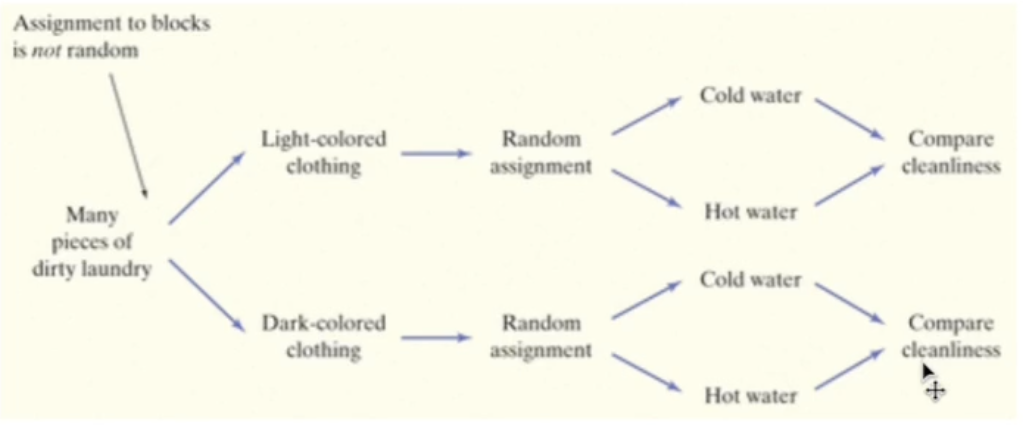
4.3: Facets of Experimental Design
The Placebo Effect
Placebo: a pill/drug that looks and tastes like the real thing, but has no actual effect on the individual taking it
Placebo effect: when the patient’s belief that a treatment will have an effect causes an actual change to take place
Placebos are often, but not always, given as a control group
If a placebo is given and all other factors in the control group and treatment group are held constant, any differences in the results can be attributed to the treatment
Blind Studies
Single-blind study: the subjects do not know which group/treatment they are in/receiving, but the doctors/individuals measuring and interacting with the subjects do know which treatment the subject received
Or the subjects know, but the people interacting with them don’t
Double-blind study: when neither the subjects nor those interacting with them and measure the response variable know which treatment the subject received
Whenever possible, experiments with human subjects should be double-blind
Sometimes, however, double-blind studies are not possible
Major advantage — limits unconscious/subconscious bias by the researcher administrating the treatments
Block Design
Randomized block design: used when groups of experimental units are known to differ from each other and may respond differently to treatment as a group; to avoid confounding, the groups are separated into blocks and the assignment of experimental units to treatments is carried out separately within each block
Eg. females vs. males
Block: a group of experimental units that are known before the experiment to be similar in some way that is expected to affect the response to the treatment
Not formed at random (experimenter assigns experimental units to blocks)
The differences from block to block should be as significant as possible, but within each block, subjects should be similar
A good experimenter will form blocks based on the most important, unavoidable sources of variety among subjects
Randomization will then average out the effects of remaining lurking variables
Block design helps us obtain more precise conclusions

Blocks vs. Strata
Major difference: stratifying is used for sampling before an experiment is started; how subjects are identified/gathered, whereas block is the design of the experiment itself
One major similarity is that both designs divide subjects into groups based on similar features
Matched pairs design
Match pairs of similar subjects
Use random assignment to decide which member of each pair gets each treatment
Helps reduce the effect of variation among subjects
Can also be one individual that receives two treatments, and the order of treatments is randomized
Observed effects are statistically significant if the probability is larger than what would be expected if the effect was just by chance
If the principles of experimental design are followed and a statistically significant result is reached, it is good evidence that the treatment caused the effect
4.3: Facets of Experimental Design
The Placebo Effect
Placebo: a pill/drug that looks and tastes like the real thing, but has no actual effect on the individual taking it
Placebo effect: when the patient’s belief that a treatment will have an effect causes an actual change to take place
Placebos are often, but not always, given as a control group
If a placebo is given and all other factors in the control group and treatment group are held constant, any differences in the results can be attributed to the treatment
Blind Studies
Single-blind study: the subjects do not know which group/treatment they are in/receiving, but the doctors/individuals measuring and interacting with the subjects do know which treatment the subject received
Or the subjects know, but the people interacting with them don’t
Double-blind study: when neither the subjects nor those interacting with them and measure the response variable know which treatment the subject received
Whenever possible, experiments with human subjects should be double-blind
Sometimes, however, double-blind studies are not possible
Major advantage — limits unconscious/subconscious bias by the researcher administrating the treatments
Block Design
Randomized block design: used when groups of experimental units are known to differ from each other and may respond differently to treatment as a group; to avoid confounding, the groups are separated into blocks and the assignment of experimental units to treatments is carried out separately within each block
Eg. females vs. males
Block: a group of experimental units that are known before the experiment to be similar in some way that is expected to affect the response to the treatment
Not formed at random (experimenter assigns experimental units to blocks)
The differences from block to block should be as significant as possible, but within each block, subjects should be similar
A good experimenter will form blocks based on the most important, unavoidable sources of variety among subjects
Randomization will then average out the effects of remaining lurking variables
Block design helps us obtain more precise conclusions

Blocks vs. Strata
Major difference: stratifying is used for sampling before an experiment is started; how subjects are identified/gathered, whereas block is the design of the experiment itself
One major similarity is that both designs divide subjects into groups based on similar features
Matched pairs design
Match pairs of similar subjects
Use random assignment to decide which member of each pair gets each treatment
Helps reduce the effect of variation among subjects
Can also be one individual that receives two treatments, and the order of treatments is randomized
Observed effects are statistically significant if the probability is larger than what would be expected if the effect was just by chance
If the principles of experimental design are followed and a statistically significant result is reached, it is good evidence that the treatment caused the effect
 Knowt
Knowt
